Vol 1 No. 16 TROPIC LIGHTNING NEWS June 17, 1966
Index
[The 1966 Vietnam issues of Tropic Lightning News were published in Saigon,
and are of lower quality than later years that were printed in Japan. Over
the years the photographs and text have faded and it has been difficult to
reproduce them. Even when the photos are unclear, I have been included
them to give a sense of the activities in the Division.]
Gen. Beach Makes Visit To Cu Chi
General Dwight E. Beach, commander, United Nations Command, Korea, and Eighth
U.S. Army, recently visited the division's Cu Chi base.
Major General James H. Skeldon, chief, Marine Advisory Group, Korea, and
Major General Myung Shin Chae, commander of Korean forces in Vietnam,
accompanied General Beach.
Major General J. O. Seaman, commanding general, II Field Force, Vietnam, also
was with the party. The five generals toured the base camp and the surrounding
area by helicopter.
After their return they met with "Tropic Lightning" brigade and battalion
commanders. They were briefed on search-and-destroy operations conducted by
division elements to date. Operation "Wahiawa," one of the more recent of these
operations.
|
Four Stars |
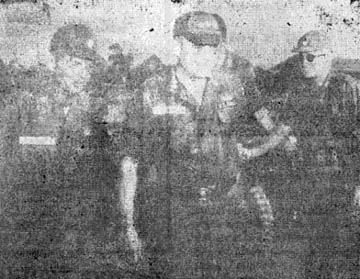 |
| VISITOR - General Dwight E. Beach, commanding general, United Nations Command, Korea, and Eighth U.S. Army, tours the headquarters area of the 1st Battalion (Mechanized), 5th Infantry, with Lieutenant Colonel Thomas U. Greer, the battalion commander. On the general's left is Colonel Thomas M. Tarpley, the 2nd Brigade commanding officer. General Beach has been named by President Johnson to succeed General John K. Waters as Commander in Chief, U.S. Army, Pacific, upon General Waters' retirement in September. (Photo by Pardue) |
Bond Drive Extended For Federal Employees
The 1966 Savings Bonds Campaign has been extended until June 30, "to assure
that every civilian and military employee of the Federal Government throughout
the world is given an opportunity to sign up for regular purchases" through the
Payroll Savings Plan.
The extension was announced by Postmaster General Lawrence F. O'Brien,
Federal Savings Bonds chairman. The drive was scheduled to end May 31.
Mr. O'Brien expressed confidence that the campaign goal of 75 per cent
participation by Federal employees will be achieved.
The postmaster general said "The 1966 campaign is the most extensive and
intensive undertaken among personnel of the Federal Government in the 25-year
history of the Savings Bond program."
"Because of its worldwide scope we are just now gaining momentum outside the
Washington area and, for that reason, I have concluded another 30 days are
needed to reach everyone on the Government payroll with the Savings Bonds
message."
Mr. O'Brien noted that President Johnson is personally following progress of
the drive. (AFNB)
Lt. Col. Cannon Becomes New CO At 1/8th Arty.
Lieutenant Colonel James W. Cannon assumed command of the 1st Battalion, 8th
Artillery, in ceremonies held recently at the Cu Chi base camp.
Col. Cannon took over the unit from its acting commander, Major Frank, E.
Deam. During the ceremonies the men of 8th Arty. were read a farewell letter
from the "Automatic Eight's" former commander, Lieutenant Colonel Robert G.
Walker, who is on his way back to the United States for retirement.
The battalion colors were presented to Col. Cannon and he returned them to
the color guard as he took command. He then told the men of his new command
that it was with great pride that he joined that unit.
Col. Cannon was formerly assigned as intelligence officer for the "Tropic
Lightning" Division.
Chamber Commends Orphanage Help
The Japanese Chamber of Commerce and Industry of Hawaii, in a resolution
dated June 6, has commended the 1st and 2nd Battalions of the 27th Infantry, and
the 1st Battalion, 8th Artillery, for their continuing support of the Holy
Family Home in Osaka, Japan.
Sidney H. Kasumoto, president of the chamber, mailed the resolution to Major
General Fred C. Weyand, division commander.
The Holy Family Home is an orphanage housing 175 children. Support of the
orphanage, now in its 16th year, has included money, food, clothing and
medicine. More than $440,000, or some $1,800 a month, has been contributed by
the units to the home.
Support started in December 1949, when the men of the 27th Inf. planned a
Christmas party for the orphans. The 27th was stationed in Japan at the time.
Some of the soldiers visited the orphanage and, noticing the misery and poverty,
decided that one day of pleasure and 364 of hardship was not right. The project
of full-time support was born then.
The resolution conveys the chamber's deep and abiding respect and admiration
for each and every individual of these celebrated units. The chamber also cites
the officers and men for upholding the highest ideals of Americanism for both
risking their lives in the defense of freedom and carrying on the tradition of
support for the orphanage.
The resolution also notes that, once again, these "Tropic Lightning" soldiers
have proved they are "the finest fighting men in the world."
New Training Film Now Available
NEW 17-MINUTE training film for orienting troops going overseas has been
prepared by Army's Chief of Information office. The 16mm film covers overseas
duty requirements and Code of Conduct. It will be available at end of June
through Audio-Visual Service Centers under code AIF-16 (DA Pamphlet 108.9).
Ring Tiffs To Begin Next Month
Amateur pugilists, start your training! The division boxing program is
scheduled to begin next month.
Competition will take place in 10 weight classes for those fighters eligible
under Amateur Athletic Union rules. There will be four teams consisting of the
1st Brigade, 2nd Brigade, Division Artillery, and Support Command With Division
Troops.
The matches will consist of three, two-minute rounds with one-minute rest
periods. Points toward a team's first and second place trophy will be awarded
on a 5-3-1 basis: five points for each fight won by a team, three for each
fight lost by a team, one point for a forfeiture.
A man will fight in one of four classes: novice, intermediate, experienced
and open. He may change classes according to his performance.
Details may be obtained through major commanders or the Special Services
office.
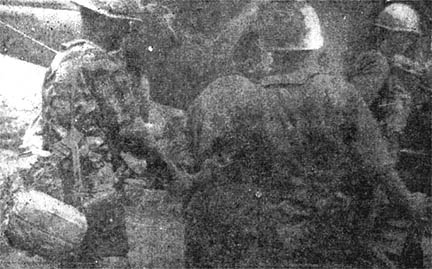 |
PRISONER - Members of the 2nd Battalion, 35th Infantry's reconnaissance platoon tie the hands of a captured Vietnamese soldier before putting him aboard a helicopter, during Operation "Paul Revere." (Photo by Nelson) |
Page 2 TROPIC LIGHTNING NEWS June 17, 1966
Decorated
| BRONZE STAR MEDAL (With "V" Device) | |
|
Sgt. Tony R. Arriaga, Co. A, 4/9th Inf. Sp4 Leon Black, A Trp., 3/4 Cav. SSgt. Haold K. Kinabrew, A Trp., 3/4 Cav. |
Sp4 Ronald S. Klonowski, A Trp., 3/4 Cav. 1st Lt. Eldon M. Wirtz, Co. A, 2/27th. Inf. |
| ARMY COMMENDATION MEDAL (With "V" Device) |
|
|
SSgt. Samuel McCartney. HHC, 1/5th Inf. Sp5 Luis F. Ramos-Deliz, HHC, 1/5th Inf. |
SSgt. Alejandro D. Rendon, HHC, 1/5th Inf. |
| PURPLE HEART |
|
|
Sgt. William F. Anders, Co. A, 1/5th Inf. PFC Jerry V. Arnold, Co. A, 1/5th Inf. Sp4 Monty L. Goree, Co. A, 1/5th Inf. PSgt. Willie Hicks, Co. C, 25th Med. Bn. Sp5 Sammie L. Kay, Co. C, 25th Med. Bn. Sp4 William J. Keener, Co. C, 25th Med. Bn. PFC Edward D. Logan, Co. C, 25th Med. Bn. PFC Kenneth A. MacDonald, Co. C, 4/9 Inf. PFC Anthony B. Mills, Co. C, 25th Med. Bn. Sgt. Theodore W. Mills, Co. A, 1/5th Inf. Sp4 Horace Mitchell, Co. B. 2/14th Inf. PFC Garfield H. Morgan, Co. D, 25th Med. Bn. PFC Loydell Payton, Co. A, 1/5th Inf. |
Sp4 Henry O. Powers, Co. A, 1/5th Inf. Sp5 Melvin J. Rhodes, Co. C. 25th Med. Bn. Sp5 Richard A. Spangler, Co. C, 25th Med. Bn. PSgt. Robert E. Victory, HHC, 4/23rd Inf. Sp5 Robert O. Walker, HHC, 4/9th Inf. Sp4 William A. Weir, Co. B, 2/14th Inf. Sp5 James F. Wewer, HHC, 65th Engr. Bn., Sgt. Allen R. Whitman, HHC, 2/14th Inf. PFC Douglas C. Wilkerson, Co. C, 1/5th lnf, Sp4 L. J. Willie, Co. B, 4/9th Inf. Maj. Walter Witala, Co. C, 25th Med. Bn. SSgt. Nathan B. Woolsey, B Btry., 7/11th Arty. Sp4 Kent C. Wright, Co. C, 4/9th Inf. |
Oriental Philosophy Guides VC
During the past few weeks this page has offered a history of the enemy and
his tactics in order that his ruses can be understood and avoided. Another
facet of knowing the enemy is knowing how and why he thinks as he does.
The "new kind of war" being waged today in Vietnam has its roots in an
Oriental concept of war developed some 22,500 years ago. The philosophy was
recorded in a 13-chapter book called "The Art of War," written by a Chinese, Sun
Tzu.
Sun Tzu's ideas have been expanded and refined by many men throughout
Oriental history, including Red China's Premier Mao Tse-tung and General Giap,
North Vietnamese military commander.
Sun Tzu posits that the primary consideration of waging war is to know the
enemy as well as yourself. He stresses the mental aspect of conflict. The
primary target is the mind of the opposing commander. If his actions and
reactions can be controlled or manipulated victory is assured.
Of strategy, Sun Tzu says that winning 100 victories in as many battles is
not a true sign of greatness, but that subduing the enemy without a fight is the
pinnacle of skill.
Thus, the strategy most important is to attack the enemy's strategy. The
next best is to destroy his alliances, and then, only if neither strategy can be
accomplished, attack his army.
Sun Tzu suggests how a strategy of avoiding contact can be carried out.
Plans and projects that cause injury to the enemy should be varied and diverse
in both purpose and method.
He suggests luring away the enemy leader's counselors and advisors. Or place
agents in the enemy's important offices. Or use deception to alienate the
enemy's allies from him.
He maintains that it is always advantageous to capture a state or an opposing
force in tact and without fighting if possible. Sun Tzu thinks that there is a
psychological advantage in the strategy beyond the obvious material wealth to be
gained.
The overall idea of Oriental strategy is to win the battle before it ever
takes place. Speed and deception must be used to bring off such victories or
the chance to confound the enemy and make him helpless will be lost.
Sun Tzu was a great believer in the value of intelligence and
reconnaissance. His proposed uses of intelligence activities are remarkably
applicable to the subterfuge of the Viet Cong. Secret agents were already a
going concern in his day so his ideas on the subject are well founded.
Tzu places the secret agent in five categories: native, inside, double,
expandable and living. An example of a native agent would be a VC sympathizer
who passes information to the communists. An inside agent could be a VC in an
official government post. A double agent would be a South Vietnamese spy
actually working for the Reds.
The final two categories are indicative of the dispassionate Oriental
philosophy of war. An expendable agent would be any unknowing communist agent
who was leaked false information and then given over to the Free World forces
where he could only reveal misleading information.
Ironically, the living agent is anyone who returns alive with information.
Sun Tzu says that the object of the secret agent is simply to determine what
the enemy's plans are. He can do this by controlling the avenues of approach to
the enemy leader, or can agitate him so he shows his hand.
Although these thoughts are centuries old they are an almost perfect
description of the way the communists are carrying on the war in Vietnam. By
knowing the reason behind their methods it is possible to retaliate and thus
reduce their effect.
Control Pets, Mascots; Avoid Rabies Threat
Cu Chi has become a haven for a number of mascots, pets, orphans, and plain
old "camp followers." These animals are a source of pleasure for many Tropic
Lightning soldiers. But caution and foresight must be exercised in order that a
fuzzy puppy does not turn into a killer.
Rabies is a disease of mammals. Because domestic animals can be
controlled, the greatest danger of contracting the disease is from wild
animals. Wild animals can infect a pet with rabies and the disease can then be
transferred to humans by their own animal.
Humans catch rabies when they are bitten or scratched by a rabid animal.
Naturally not everyone dies every time they are scratched or bitten, but the
threat of rabies necessitates medical attention every time an animal wounds a
human being.
Even pets will attack an owner without provocation if they are rabid.
Unprovoked attack is a good indication that the animal may be sick, so
preventative measures must be taken.
The attacking animal must be watched for a period of four to five days to see
if he displays the symptoms of the disease. If the animal cannot be quarantined
a person might have to take preventative treatment without having the disease.
The best way to guard against a pet catching rabies is to keep him from
having any contact with wild animals. Pets can, and should, be inoculated
against rabies and must receive boosters annually.
Savings Bonds Are Security For You and Your Country
Why Savings Bonds? That is one of the first questions a serviceman asks
himself when he thinks of purchasing a bond.
There are a number of good reasons for buying bonds. Perhaps the best of
these is that they provide a nest egg for your future. No matter what your
plans are, U.S. Savings Bonds can provide the money for you to attain your goal.
U.S. Saving Bonds now have a higher interest rate than ever before. The new
rate of 4.15 per cent means when you buy a $100 bond you pay $75 and receive
$100 at its seven-year maturity.
In addition to helping yourself, you are helping your country. You are
investing in the future of your country and helping the national interest.
U.S. Savings Bonds can't be lost or stolen. If anything happens to your bond
it will be replaced free of charge. You always have your money waiting for you
when you want it.
When you buy a U.S. Bond your money is working twice. It is working for you
and for your government.
Army, Air Force Reduce Postage For VN Service
Want to pass along a real bargain? Tell your relatives and friends what a 5c
stamp will do. You may now send mail from the U.S. to a serviceman in RVN for a
nickel. The Post Office Department airmails it to San Francisco and the
military services carry it to Saigon by air.
This is one of the new services provided by the Army and Air Force Postal
Service, operating under TAG. Be sure to tell the folks to address their
letters accurately, including the 5-digit APO number. Also keep them advised of
any change of address.
If legislation pending before Congress is enacted, there will be further
bargains.
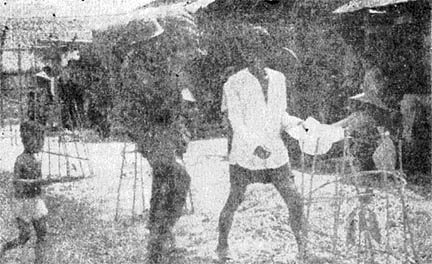 |
DONATION - A soldier of the 3rd Squadron, 4th Cavalry, carries a bag of rice to the hut of a Bac Ha villager during a recent civic action program conducted there. The rice was taken from Viet Cong caches during Operation "Wahiawa." |
| The TROPIC LIGHTNING NEWS is an
authorized publication of the 25th Infantry Division. It is published
weekly for all division units in the Republic of Vietnam by the
Information Office, 25th Infantry Division, APO U.S. Forces 96225. Army
News Features, Army Photo Features and Armed Forces Press Service material
are used. Views and opinions expressed are not necessarily those of the
Department of the Army. Printed in Saigon, Vietnam, by Dai Doan Ket
Publishing Company. Maj. Gen. Fred C. Weyand . . . . Commanding General Maj. William C. Shepard . . . . . . Information Officer 2nd Lt. Patrick J. McKeand . . . Officer-in-Charge Sp5 Dale P. Kemery . . . . . . . . . Editor PFC David A. Pierce . . . . . . . . Editorial Assistant |
Page 3 TROPIC LIGHTNING NEWS June 17, 1966
1/5th Inf. Captures VC Horde
In what was described by officials as "one of the largest single hauls of
prisoners in the III Corps area," the reconnaissance platoon of the 1st
Battalion (Mechanized), 5th Infantry, captured 19 Viet Cong and killed 11 more
in less than an hour.
The action took place recently during the initial hours of Operation "Makiki,"
a 2nd Brigade search-and-destroy mission near the Oriental River in Hau Nghia
Province about 25 miles northwest of Saigon.
From his command helicopter, Lieutenant Colonel Thomas U. Greer, battalion
commander, of Gainesville, Fla., observed several Viet Cong running toward a
hedgerow. He directed the recon platoon to move into the area.
Specialist 5 Luis Ramos-Deliz, of Quebradillas, P. R., the track commander of
the first armored personnel carrier (APC) to reach the location, said that his
vehicle criss-crossed the area for nearly 20 minutes without finding a thing.
Two more units from the platoon aided in the search.
Sp5 Ramos said, "After looking without finding anything for a while, I
stopped the track and got out. I was walking around the APC when I saw a
'Charlie' underneath it. The water was knee deep all over and in some spots
where there were holes it was a lot deeper. The VC," Ramos added, "was hiding
underwater and breathing through a reed."
Once this discovery was made, the three tracks at the location stopped and
the wet search began.
Specialist 4 Terry Kessler, 23, of Hutchinson, Kan., said, "The only way you
could find them was by stepping on them."
Added Private First Class Milton Jones, 22, of San Antonio, Tex., "I'd been
walking where the track had already been for 30 minutes. The water was up to my
waist and the mud bottom made it rough going. I'd move along, spot air bubbles,
yank the reed and up would come a 'Charlie'."
The men from the first three vehicles accounted for 10 VC before the other
four APC of the platoon arrived. Then, under the command of 1st Lieutenant
James E. McQuinn, of Indianapolis, Ind., they swept the area and captured or
killed the 20 other VC.
Intelligence reports said that the 30 men captured or killed were members of
a 50-man local guerrilla force. One of the captured men, who came out of the
water with his bolt action Chinese carbine said he had joined the unit only a
week earlier.
The entire action took place without a friendly casualty.
Parties Welcome Wolfhounds Back From Operations
It might have been Al Hirt, or the Tijuana Brass, or the Hawaiian strains of
Don Ho, but it was actually a pickup group from the 25th Division Band that
entertained Company C of the 2nd Battalion, 27th Infantry "Wolfhounds," when
they returned from Operations "Wahiawa" and "Makiki."
The company mess sergeant, Staff Sergeant Ronald K. Auld, of Honolulu,
Hawaii, regularly arranges the welcome home party with a friend of his in the
band, and the cooks go all out to prepare a feast for the tired infantrymen.
Between renditions of "Downtown" and "I Wanna Go Back to My Little Grass
Shack" the "Wolfhounds" wolfed down charcoal grilled steaks, vegetables, fresh
rolls and cake, and plenty of cold drinks.
As the band played on, the men broke into smiles, forgetting the troubles of
the battlefield - until the next operation - and welcome home party.
| BABY-SAN - A young Vietnamese girl holds her little sister who has just been treated by division medical personnel. The pamphlet she is holding explains the medical service, one of many included in the civic action program. |
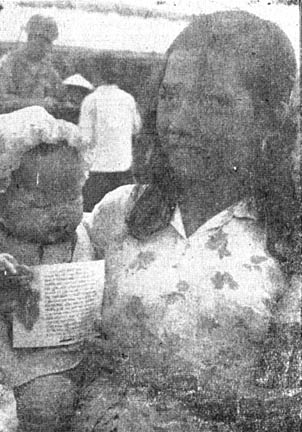 |
The reconnaissance platoon From Headquarters Company, 1st Battalion, 27th
Infantry, discovered a Viet Cong hand grenade factory which they estimated being
capable of producing 400 to 500 grenades a week while on Operation "Makiki," 10
miles southwest of Cu Chi last week.
The platoon leader, Staff Sergeant Bertram W. Fritz, of Cincinnati, 0h., said
the factory probably supplied all the VC units in the area. It took two days
for Sgt. Fritz and his men to reach the factory due to extensive booby traps and
land mines surrounding it.
Sergeant Jerry Whitehead, of Talahassie, Tenn., platoon scout section leader,
said the men found about one thousand booby-trapped grenades surrounding the
factory.
Once they reached the factory the platoon found a cache of sulphur, which the
grenades are believed to be made of, casts, forging tools, and a supply of blue
handles for the grenades.
Sergeant Thellie Casper, of Aulander, N.C., team leader, said the grenades
smelled like sulphur and were not too powerful but found their score. The men
suffered several injuries while clearing, the area.
It is believed the VC knew the "Wolfhounds" were coming and used the grenades
for the booby traps which the platoon encountered.
After the area was cleared and the equipment confiscated, the "Wolfhounds"
destroyed the large concrete building which housed the factory.
"Dustoff" Quick to Save Lives
"Dustoff coming in!" The radio call spurs the men of Company B, 25th Medical
Battalion, 3rd Brigade, to prepare for the reception of patients.
On Operation "Paul Revere," elements of the task force met heavy contact with
what they now know to have been a North Vietnamese regiment.
"Every wounded man who reached our hospital alive, reached the next higher
echelon alive thanks to the finest doctors I have ever worked with," said
Captain William Gardner, the "Bronco" Bde. surgeon.
All patients suffering head or eye injuries were immediately evacuated to
Pleiku or Qui Nhon. Other patients requiring major surgery are evacuated either
to Pleiku or An Khe.
"A seriously wounded man can be on an operating table in Pleiku within a half
hour after he reaches us," stated Edward Denison, the Company B commander.
"Although we have full surgical facilities, we don't use them unless it is a
dire emergency," Capt. Gardner pointed out.
"We hold all patients we feel we can get back to duty within a week. All
others we evacuate," Capt. Denison said. The company holds an average of 30-35
patients per day.
The doctors voiced great respect and admiration for the dustoff pilots and
medics.
"They have lost two choppers during this operation while attempting to
extract wounded soldiers from the battle areas," Capt. Gardner emphasized.
"They also had a medic shot in both legs."
The dustoff unit supporting the 3rd Bde is the Pleiku platoon of the 498th
Helicopter Air Ambulance Company.
"This dustoff system is the major reason that this war has such a low
mortality rate. Lower than any other war. There is less than two per cent
mortality after the casualty reaches the first medical facility," Capt. Gardner
noted.
Third War Worst Says Inf. Sergeant
Platoon Sergeant Konelio Pele is now fighting his third war and he says this
one is worse than any other. Having, seen much action with his unit, Company A,
1st Battalion, 35th Infantry, during Operation "Paul Revere," he speaks from
experience.
In describing some of the differences between this and his other two wars,
Pele observed, "In the other wars you knew where the front line was, in this one
they hit you from everywhere. You face the front, send out a patrol, and get
hit from the rear. You turn to the rear and fight the people behind you, and
you get hit from the front. You've got to sit right there in the middle."
According to the sergeant, "The main thing when you take the patrol out is to
tell your people what they're supposed to do if you get hit from both ways.
You've got to split your squad so that half fight to the front and half to the
rear."
| TAKE THAT ! - Major Frank E, Deam, Executive Officer, 1st Battalion, 8th Artillery, is shown pulling the lanyard of a 105mm howitzer to send the "Automatic Eighth's" 75,000th round of firepower into a Viet Cong position. (Photo by Pardue) |
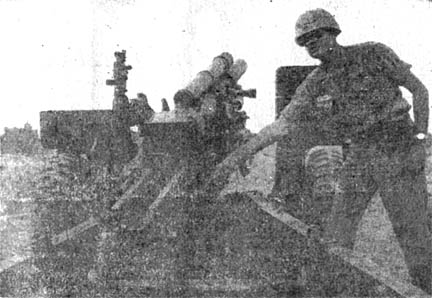 |
Page 4 TROPIC LIGHTNING NEWS June 17, 1966
"Makiki," Actions Range From...
Twenty-Fifth Infantry Division soldiers made the largest capture of arms
and ammunition in many months and killed 21 VC during Operation "Makiki," which
ended last week. The week-long search-and-clear operation took place 30 miles
northwest of Saigon in Hau Nghia Province.
Thirty-two Viet Cong and 53 suspects were captured by the "Tropic Lightning"
soldiers. Arms and ammunition taken included 110 small arms and 57,740 rounds
of ammunition. The VC also lost 26.4 tons of grain, 47 sampans, 43 tunnels and
29 buildings.
General William C. Westmoreland, commander, U.S. Military Assistance Command,
Vietnam, made a special trip to inspect the captured material, calling it a fine
accomplishment by the 25th.
As with all operations, this Medical Civic Action Program (MEDCAP) and the
"Tropic Lightning Helping Hands" project were used on Operation "Makiki,". MEDCAP
physicians treated 491 patients in the operational area while "Helping Hands"
distributed a half ton of rice, 1,700 pounds of clothing, 430 bars of soap and
50 dental hygiene kits.
Division spokesmen, assessing the results of the operation, said "Makiki,"
deprived the Viet Cong of much weapons and ammunition, hopefully preventing them
from causing significant difficulty in the near future.
General Inspecting Booty to...
General William C. Westmoreland, commander, U.S. Military Assistance Command
Vietnam (MACV), visited the division last week and inspected captured Viet Cong
arms and ammunition taken on Operation ""Makiki,"".
The captured equipment included small arms, automatic weapons, high
explosives and ammunition. The majority of the weapons captured were Chinese
but much of the ammunition was of Russian manufacture. Major J.C. Baker,
technical intelligence officer for MACV, in briefing General Westmoreland, said
that this was the first time Russian ammunition had been captured in any large
capacity.
General Westmoreland visited the 1st Battalion (Mechanized), 5th Infantry,
the unit that captured the material. He presented Army Commendation Medals to
Captain Willie A. Blair, Sergeant James W. Ivey Jr. and PFC Cleo O. Ford, the
men who discovered the cache.
The general expressed his pride in the three men's achievements and urged
them to continue to display the aggressiveness and determination that had marked
their unit in the past.
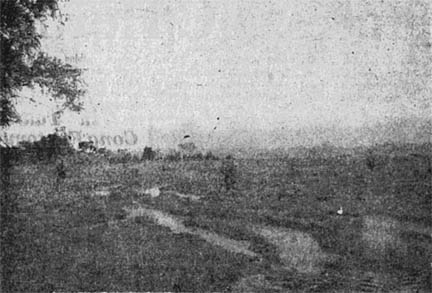 |
WATERLOGGED - Soldiers of 1st Battalion (Mechanized), 5th Infantry, search for VC in water-covered paddies on Operation "Makiki." (Photo by Vickery) |
Water Chase For Cong
"Searching" is just what the reconnaissance platoon of the 1st Battalion
(Mechanized), 5th Infantry, has in mind for the Cong and they'll even swim a
river to get their man.
This was proven on Operation "Makiki," a search-and-destroy mission near the
Oriental River in Hau Nghia Province. Operating 30 miles northwest of Saigon,
the men used nearly every means of locomotion known in Vietnam to run down the
Viet Cong.
When the command and control helicopter spotted some VC, the armored
personnel carriers (APC) went after them. When the APC's were stopped by the
waist-deep water and mud, the men waded.
When the mud gave way to small ponds and canals, the "Bobcats" started
swimming after the VC.
Swimming became impractical because the Cong had too much of a head-start
down a canal so the recon team commandeered a sampan and poled their way down
the stream.
Said one soldier, "I've taken the point before, but this is the first time I
did it from the bow of a sampan."
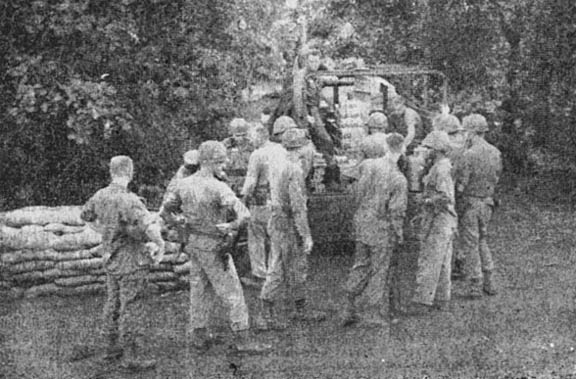 |
| PX - Soldiers of the 3rd Brigade Task Force take time out from Operation "Paul Revere" to stock up on supplies from the field PX. The men fought on this operation for over one month so the PX was brought from base camp to the forward area. (Photo by Sutphin) |
On Operation "Paul Revere" While Men In Field...
The "Tropic Lightning" 3rd Brigade Task Force continues to sweep the area
west-southwest of Pleiku on Operation "Paul Revere."
Since the operation began more than a month ago elements of the brigade have
accounted for 279 North Vietnamese and Viet Cong killed. Air strikes in support
of the operation have netted 43 more enemy dead. Thirty soldiers of the North
Vietnamese Army have been captured in action and four "Chieu hoi" have come over
to the government.
Most of the action occurred during an encounter 2 1/2 weeks ago which saw men
of the task force in heavy engagement with what was later estimated to be a
North Vietnamese regiment. The Communists broke contact and withdrew to the
west. Contact has been light since that time.
A total of 68 small arms and 49 automatic weapons have been captured by the
"Broncos" in addition to large quantities of ammunition, rice, barley and salt.
Three hundred ninety-eight huts, 42 bunkers and 17 tree-houses have been
destroyed.
The 3rd Bde. Has suffered light casualties overall during the fighting, but
several small units have had moderate casualties.
Rain Howitzer Fire on NV Army
The 2nd Battalion, 9th Artillery, boasts of one of the most charged
batteries in Vietnam.
During the 3rd Brigade's recent heavy contact with the North Vietnamese Army
units, additional firepower was needed. As a result, Battery A, of the "Mighty
Ninth," was brought into action.
During one afternoon and night they expended more than 1,500 rounds. Because
of the heavy enemy fire coming in on the infantry companies, the battery fired
for 24 hours without a break. All the while small arms and mortar fire were
falling on the battery.
The action recently took place on Operation "Paul Revere." First Lieutenant
Richard Higgins, who was commanding the battery at the time, had this praise for
his men: "It really made me proud to see the men in this battery because they
were up shooting their howitzers to save those other men (infantrymen) at the
same time the mortar rounds were landing in this area."
| BRIEFING - General William C. Westmoreland, commander, U.S. Military Assistance Command, Vietnam, listens intently to Major J. C. Baker (r), a technical Intelligence officer on the general's staff, explains the use of a captured Viet Cong weapon. Lieutenant Colonel Harley Mooney (left rear), division intelligence officer and Major General Fred C. Weyand, division commander, inspect the weapons. (Photo by Park) |
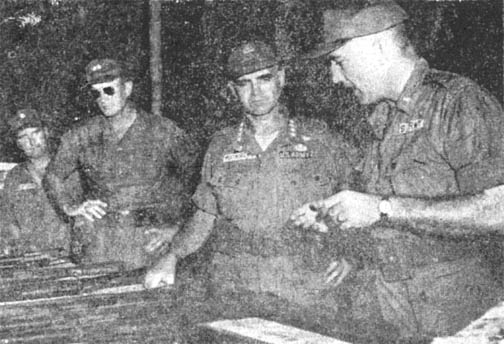 |
Curious Mascot Found...
"Golden Dragons" of the 3rd Brigade recently captured a Vietnamese dragon
on Operation "Paul Revere." Men of the 1st Battalion, 14th Infantry, "Golden
Dragons," dragged in a four-foot iguana found wandering near a 3rd platoon
Company B, surveillance post.
The men thought the iguana would make a good mascot. The company's
commanding officer, Captain Richard Barry, agreed and presented the animal to
Lieutenant Colonel Gilbert Procter, battalion commander. The new found "dragon"
reminded the colonel of a cartoon character that had appeared in the battalion
newspaper and he named the iguana "Danny Dragon."
Danny now resides near the battalion command post tied to a nearby tree by a
rope attached to his harness. The men of the battalion built a hootch for him.
There are, however, problems that must be dealt with when an iguana is your
mascot. Within a few days after Danny arrived at his new home several men had
to spend the better part of an afternoon extracting him from the crankcase of a
jeep where he had become lodged.
| DRAGON - Members of the 1st Battalion, 14th Infantry, "Golden Dragons," part of the division's 3rd Brigade, admiring their new mascot, an iguana captured on Operation "Paul Revere." (Photo by Martens) |
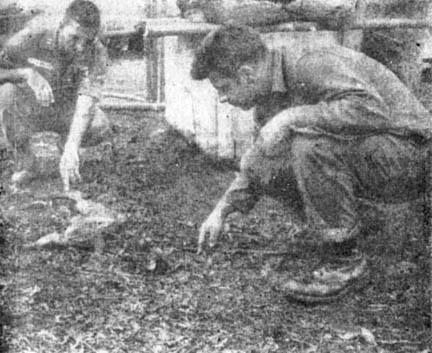 |
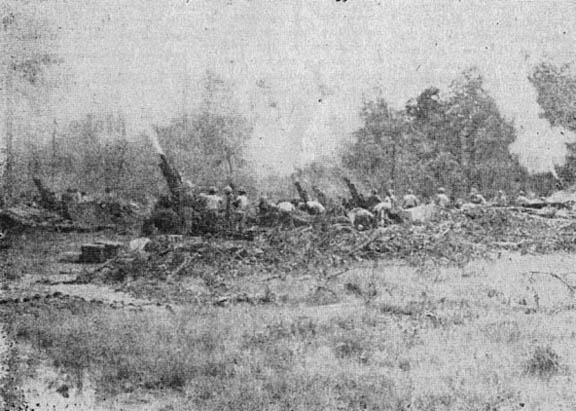 |
| FIRE! - Charlie Battery fires at 'Charlie.' 105mm howitzers of Battery C, 2nd Battalion, 9th Artillery, are fired on Operation Paul Revere. (Photo by Sutphin) |
Page 6 TROPIC LIGHTNING NEWS June 17, 1966
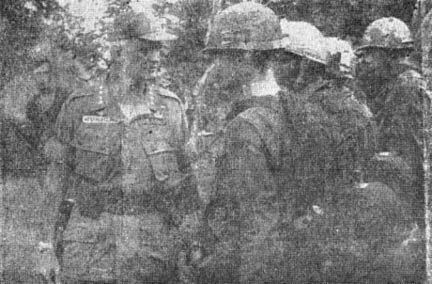 |
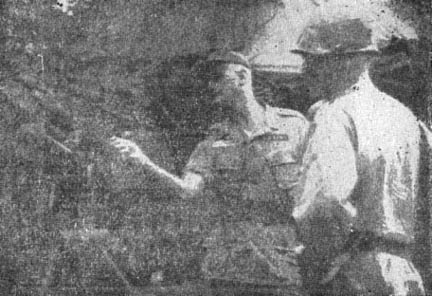 |
| CONGRATULATIONS - General William C. Westmoreland, commander of all American forces in Vietnam, congratulates men of Company B, 2nd Battalion, 35th Infantry, for an outstanding job done during a battle which overwhelmed elements of the North Vietnamese Army during the 3rd brigade's Operation "Paul Revere." (Photo by Nelson) | CAPTURED - General Westmoreland looks at a 12.7mm anti-aircraft weapon captured by the 2nd Battalion, 35th Infantry, forces during the same operation southwest of Pleiku. With General Westmoreland is Brigadier General Glenn D. Walker, the 3rd Brigade Task Force commander. (Photo by Nelson) |
Gen. Westmoreland Lauds 2/35th Feat
Taking a page from the Viet Cong manual, 3rd Brigade has added five North
Vietnamese anti-aircraft guns to its arsenal.
But, as Company B, 2nd Battalion, 35th Infantry, found, stealing "ack-ack"
guns from the Communists isn't quite like filching oranges on the block; the
guns almost stayed with their original owners.
The company, in the middle of Operation "Paul Revere," was airlifted into a
landing zone which turned out to be a hornets' nest. Before the choppers could
set down, the first wave received heavy enemy fire. Company B returned fire and
immediately counterattacked the enemy stronghold.
Battalion Commander Lieutenant Colonel Philip Feir had this assessment of the
combat assault, "We feel very fortunate to have gotten them (the assault force)
into the landing zone at all because we rounded up five 12.7mm anti-aircraft
weapons in the landing zone. As a matter of fact, we were able to get into
those positions in two cases before the North Vietnamese Army soldiers could get into the weapons area themselves."
Col. Feir pointed out that these were the first anti-aircraft weapons that
the 3rd Bde. Task Force has captured.
Division Treats Vietnamese Laborers
Toting handbags and wearing hats to keep the sun out of their eyes, more than
1,000 Vietnamese men, women and children crowded into the division's
amphitheatre recently for a celebration in their own honor.
It was Laborer's Appreciation Day and Vietnamese workers in the Cu Chi base
camp were treated to both American and Vietnamese entertainment, in addition to
a big feast.
Members of the "Tropic Lightning" band opened the show with a variety of old,
familiar tunes, including many favorites from Hawaii.
The highlight of the day's festivities came when a Vietnamese cultural show
took the stage and captivated their own people with everything from clown acts
to dancing girls. Adding to the color of the occasion were Vietnamese folk
dances and even a Vietnamese version of the Beatles.
The cultural group, a traveling show sponsored by the 6th Psychological
Operations Battalion, is designed to show the Vietnamese people some of their
own culture.
The food for the big, noon meal was prepared by Army cooks, who also enlisted
the aid of two local chefs. After the celebration, the workers were given a ten
kilo bag of rice, canned milk and the rest of the day off.
Laborer's Appreciation Day was set up at the request of Major General Fred C.
Weyand, division commander, to show the Vietnamese employees how much the 25th
appreciates their work.
Major Edward F. McManus, project officer for the "day," assembled a small
task force to insure an enjoyable time would be had by the 1,000-plus men and
women.
Preparation of the fried rice, assorted cooked and raw vegetables, tea
(iced), and an American addition to the menu, a huge chocolate cake, was the
responsibility of cooks from the 25th Military Police Company and 25th Supply
and Transport Battalion.
Captain Tung, a Vietnamese liaison officer with the division, said, after the
last of the several hundred pounds of rice and other food had disappeared, "All
the laborers were very appreciative that the 25th Division thought so much of
them to give them this day."
Mail-Hungry Soldiers Badger Clerk With Jibes, Jokes, Occasional Threats
Rain, hail, sleet and snow - common hazards of mailmen the world over.
Outside of an occasional unhappy dog, however, the risks are minimal in
delivering the mail.
But Army postmen have most of the usual problems - and hordes of mail-hungry
customers virtually threatening bodily injury besides.
Specialist Four Joe W. Collins, of Clarksdale, Miss., mail clerk for
Headquarters and Headquarters Company, 2nd Brigade, is representative of the
harried lot of a military mailman.
While Collins has only 200 patrons, occasionally he feels as if he has half
the division baying outside his mail room.
"When the mail is late, some of them are very impatient," Collins says. "A
lot of them don't like to wait. One time I was just bringing in the mail when
someone asked me if he had any mail. I'm not sure how I was supposed to know
when it was still in the postal sacks."
But when the mail fails to arrive, Collins plants his feet firmly on the
ground to withstand the withering barrage from the men.
Some of them joke with me when they don't get any mail," the 23-year-old
Collins remarked. "They'll tease me and tell me I'm holding back their mail.
They see me during the day and holler, "Collins! Where's my mail?"
But it can become a trying, job when his stomach is affected. On one
occasion, Collins was walking through the mess line when one of the cooks
dropped his serving spoon and yelled, "Hey, Collins! I didn't get any mail
today. I'm not going to feed you if I don't get any tomorrow."
But the long-suffering mail clerk is still eating. "If they don't get any
mail, I tell them that I'll write them a letter," he said. "All they want is
someone to write to them."
Collins, smiling wryly, claims the problem of those not receiving mail could
be alleviated "if all those lovely, young girls in America would just send their
addresses to me."
As it is now, he receives letters addressed to "Any GI in Vietnam," and the
limited supply immediately disappears.
Collins job must, of necessity, be one of devotion for he frequently is up
until late hours at night sorting mail, while the rest of the company enjoys the
nightly movie.
But he manages to take most of the ribbing in stride with a good natured
shrug. "It isn't too bad," he observes. "At least as the unit mail clerk I can
be assured of seeing all of the men every day. I don't have to worry about
finding them because they always find me" - in spite of wind and dust and
monsoon rain.
Team Treats Sick; Gets Plumbing Job
A primitive water fountain recently drew the attention of a 3rd Brigade civil
affairs team conducting a sick call in the village of Plei Jong Le and prompted
the construction of a modernized water system for the village.
The members of the teams were treating the sick when they noticed a woman
getting water from an underground stream through a single, small bamboo reed.
Talks with the village chief and residents of the village that afternoon
revealed that they all wanted a new water system but did not know how to go
about improving the old method.
With the advice of the civil affairs team, three, four-foot pipes supplied by
the U.S. Agency for International Development and the enthusiasm and hard work
of the villagers themselves, a new spillway was constructed. The new spillway
greatly increases the volume of water that could be obtained from the stream.
"THANKS" COME FROM LOCAL TOWNS
Letters of thanks from local Vietnamese continue to he received by division
headquarters. The most recent letters, from the chief of Khiem Hahn District
and chief of Ben Vang village, were sent to thank the division for a donation of
over 18,000 pounds of rice.
This donation of rice, captured from the Viet Cong on Operation "Wahiawa,"
is part of the overall program of civic assistance extended to the people in the
division's area of operations.
The letters put special emphasis on "Operation Helping Hand" which has
provided daily necessities, including clothing, soap, toothpaste, combs,
mirrors, food, etc.
They state, in part, "Almost all of the people in this area are very poor and
the help of the 25th Division is good and necessary... My people receive these
gifts with great happiness. Today the great help of the American people and the
25th Division has proven that the Americans are sincere in their desire to help
the people of South Vietnam.
"Before the 25th's arrival, the Viet Cong spread propaganda. The National
Government would call the people to work for them as laborers and then would
force them into the army." The letter continues, "but everything was to the
contrary. The U.S. Army built roads and bridges . . . made it possible for our
children to go to school and for our sick to be cured."
Page 7 TROPIC LIGHTNING NEWS June 17, 1966
Objector Fights as Corpsman
He's red-haired and freckle-faced and he goes out on ambushes and patrols
like others in the 2nd Battalion, 27th Infantry. But one thing holds Private
First Class Paul Widtfeldt apart from the others: he won't carry a weapon.
PFC Widtfeldt is one of 11 conscientious objectors in the 2nd Brigade and
like the others, he works as a combat medic.
"Lots of` people have the idea that if a man doesn't carry a weapon he's no
good," said Specialist 6 James H. Warner, the 2/27th medical platoon sergeant.
I've got three CO's (conscientious objectors) now and they're well liked. They
take care of their men, and that's what counts."
PFC Widtfeldt talked freely shout his religious beliefs. "The Bible says
'Thou shalt not kill.' and because I was raised to follow the Bible, I can't
carry a weapon."
He belongs to a non-denominational religious group, which he says, "the
government has named Plymouth Bretheren. Probably because its origins are in
Plymouth, England." His parents live in Council Bluffs, Iowa, and his father
was a CO in World War II.
"I feel the same as everybody else in combat - scared. But I can't carry a
weapon. My only protection is my faith in God. His will comes first.
"God allowed me to come to Vietnam, but I have no right to expect Him to
preserve me," the 21-year-old PFC firmly added.
Does he pray for help?
"Yes, I pray and ask God to preserve me - if He sees fit to do so," answered
the devout medic.
The men of Company C, for the most part, accept his beliefs. "I'd rather
have them ask me questions than stand back and wonder," he says.
"Some of them object to the fact that I won't pick up a weapon and start
shooting if I've no patients to take care of. But I think most of them try to
understand."
Men who've been in action with PFC Widtfeldt have nothing but the highest
praise for him. One said, "We were once pinned down and there was lead flying
all over the place. Someone yelled, 'Medic,' and Paul jumped up and started
moving. He kept walking and saying 'Don't worry, I'm coming. Just keep talking
to me so I can find you.' And all the while bullets were flying all around us."
"Even when we're marching from one command post to another PFC Widtfeldt gets
no rest. When we stop he's always running up and down the line passing out salt
tablets and checking our feet. He never seems to get tired," added the
rifleman.
All of the verified conscientious objectors entering the Army are sent
directly to basic training at Ft. Sam Houston, Tex. There, they undergo six
weeks of normal basic drill, PT, bivouac and infiltration course. The only
thing they don't do is familiarize with weapons.
Since coming to Vietnam five months ago PFC Widtfeldt has gone on dozens of
reconnaissance and ambush patrols, and treated many wounded men. If anything,
he feels his faith in God has been strengthened by the experiences.
"I'll continue to do what I have been doing. I won't change. I've been
raised to believe in God, and the way I see it, I have no right to try and
protect myself if it means defying one of God's commandments."
'There'll always be wars and rumors of wars," says PFC Paul Widtfeldt, citing
Luke 21, "and although it's against my beliefs to fight, God willed me here.
And I'll do my job."
Moans, Crys Lead to Tunnels
Tunnel complexes discovered by American forces in Vietnam have been known to
contain many things, but recently the 1st squad, 1st platoon, of Company A, 2nd
Battalion, 27th Infantry, discovered a new use the Viet Cong made of tunnels.
Led by Sergeant Juenito Felix, the men of the 1st squad were conducting a
combat patrol along the Oriental River two miles southwest of Cu Chi.
Late one night the men heard sounds like a baby crying and a man moaning.
They decided to wait until the morning to investigate.
As the sun rose Sergeant Felix and his men searched the area for the source
of the sounds they heard the night before. As they searched the area they
discovered what turned out to be an underground hotel.
The men found three tunnels leading to three small rooms containing seven
bamboo beds, a kerosene lamp, a bottle of kerosene, and a long knife. From the
main tunnel an air shaft protruded up six feet and was covered by a jar on the
ground above. As Sergeant Felix explained, the creek nearby could have been a
mooring point for river traffic and the tunnels an overnight stopping point.
When asked about its possibly being a VC tunnel, Sgt. Felix said it could
have been used by the Viet Cong, friendly civilians or Army of the Republic of
Vietnam dependents. He said it was apparent that people had slept there the
night before.
The squad also searched a nearby hut and found a sign which read "The Viet
Cong are against the people."
Big Man Tackles Big Job for 1/5th
Captain Billy J. Hammonds is a big man with a big job. The 31-year-old
officer's 6 feet 5 inches and 230 pounds are ample qualifications to get his job
done as the new S-5 for 1st Battalion (Mechanized), 5th Infantry.
Capt. Hammanda, from Talladega, Ala., is a quiet man who likes his work -
helping the South Vietnamese villagers who live near Cu Chi.
Cu Chi District is surrounded by numerous small villages and hamlets,
including that of Ben Do, located four miles south of Cu Chi on Highway 1.
Capt. Hammonds is responsible for the welfare of the 1,000 men, women and
children who call Ben Do their home.
Last week, Capt. Hammonds, accompanied by 1st Lieutenant Donald Thompson, an
English instructor, visited the village chief to make plans for aiding the
Vietnamese.
Sitting in the shade of an open-faced store and occasionally brushing flies
away with his big hand, Capt. Hammonds discussed the needs of Ben Do residents.
Through a Vietnamese interpreter he explained, "We would like to teach the
children English. Is this possible and when may we start?"
"That would be fine," the 40-year-old chief replied. "We are not ready
today, but if you can come back in a week, the children will be at the school."
A young girl brought in tall glasses of beer and soft drinks and the
discussion went on to other areas. The village needed a well. Capt. Hammonds
agreed to help them build a public well and latrine facilities. When he learned
that a maternity home was needed, the captain said he could provide cement and
bricks to accomplish the undertaking.
"The village has 104 pigs," commented Capt. Hammonds. "We rounded up about a
fifth of them from our base camp area. They were just running wild and getting
in the way. So we donated them to Ben Do. Now the villagers are having
problems feeding the pigs."
But after each meal there are plenty of scraps at 1/5th. Before he left the
village, the captain said he thought he could deliver a truckload of garbage
several times a week. The leftovers would not go to waste, and, after treating
and cooking, would provide excellent hog food.
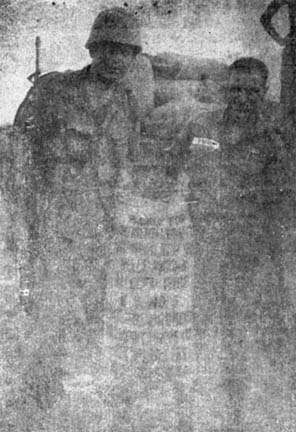 |
BIG MAN - Captain Billy J. Hammonds and 2nd Lieutenant Joseph V. D'Orso of the 1st Battalion (Mechanized), 5th Infantry, display one of the captured bags of rice to be distributed to needy villages. |
Revisit Doubles 2/14th Haul
It cost the Viet Cong 50 to 60 tons of rice in Operation "Wahiawa" when they
let a group of jungle hooligans hit a VC storage cache.
The 3rd platoon of B Company, 2nd Battalion, 14th Infantry, was securing a
route of march from Cu Chi to a command post in the Ho Bo Woods. They had the
usual problems of a patrol: the red ants, the sticky mud of the rice paddies, a
sniper or two, but nothing out of the ordinary.
On the alert for snipers, booby traps and punji pits, the men spotted a rice
cache hidden in the jungle. The rice bags were found to be booby trapped in
four places. Members of Company A, 65th Engineers, removed the explosives so
that the 25 to 30 tons of rice could be secured.
It was decided to return for the rice on the next day so that the battalion
could continue moving.
When the platoon arrived in the area early on the following morning, Private
Ernie Santa Cruz discovered an additional cache of rice as large as the first.
Lt. Muir reported the new find and was told to carry all the rice he could and
destroy the rest.
B Troop of the 3rd Squadron, 4th Cavalry, supplied 13 armored personnel
carriers and the double cache was loaded in six hours and brought to Cu Chi.
The captured rice is now helping to feed the families and men of the Army,
Republic of Vietnam, as part of the 1st Brigade's civic action program.
Hazel's Mr. "B" Spreads Cheer At Cu Chi Camp
Don DeFore, who starred with Shirley Booth in the "Hazel" television series,
recently visited the 25th at Cu Chi as part of a two-week tour of Vietnam
military bases. Mr. DeFore was recognized by many soldiers as the harried Mr.
B. (George Baxter) as he toured the base camp.
During the tour, Mr. DeFore stopped to speak to the men of different units.
He concluded his visit at the hospital, where he shook hands and chatted with
the patients.
Mr. DeFore has appeared in many movies and has several businesses as well as
having worked in the "Hazel" series.
Page 8 TROPIC LIGHTNING NEWS June 17, 1966
Candy Moocher Softens GI
By PFC John Diltmann
His name is Minh. He is 12 years old and lives in the hamlet of Ap Trang Cun.
I met him while on a search-and-destroy mission with the 4th Battalion, 9th
Infantry, about 10 miles northwest of the base camp at Cu Chi. They had set up
a road block and, with the help of some Vietnamese National Police, were
checking travelers for possible Viet Cong.
While observing the proceedings, someone walked up to me and said, "Hello,
GI. How are you today?" I looked down and saw a little boy not quite as tall
as my M-14 rifle. His black hair fell across his forehead and hung around his
ears. His white teeth sparkled in a big smile.
"I'm fine. How are you?" I said.
"Okay," was the reply.
"Do you live around here?"
"My name Minh. Live Ap Trang Cun. Mama-san in Cu Chi, wash clothes for
Merican GI."
We sat down on the bank beside the road and I asked, "Where did you learn to
speak English?"
"Merican GI," said Minh. "Teach good. Minh learn fast, you wait. Minh come
back soon."
He ran down the road and into a house. In a minute he was back with a big
bunch of bananas. He offered me one; I took it and thanked him. As we ate I
questioned: "Minh, what do you think of the war?"
"War good. Merican kill VC good."
"Do the VC come around here much?"
"VC come, Minh go."
"What do you think of American soldiers, Minh?"
"Merican number one. Minh hurt in Cu Chi. GI come, fix good."
A soldier with a bandage on his arm walked by and Minh stopped him. He
pointed to the bandage and said, "VC boom boom?"
"Yeah," said the soldier. "VC boom boom."
Minh pointed to a three-inch scar on his own leg and said, "VC boom boom.
Merican number one, VC number ten."
"Have you seen any VC?" I asked.
"VC come. Boom Boom, kill, take rice. Number ten."
The little man had analyzed the overall situation very well for his 12
years. When asked if the government forces would win the war, Minh thought for
a minute, then looked up at me and said, "VC number ten: GI number one. No
sweat."
I gave Minh a piece of candy and he gave me a piece of gum and then it was
time to go. The unit was moving down the road so I fell in line. I looked back
over my shoulder and waved to Minh and he waved back. As we walked away, I felt
good when I thought of the confidence in that little boy's voice when he said,
"VC number ten; GI number one. No sweat."
FREEDOM HAS ITS BURDENS
In a certain state there is no speed limit for automobiles on the open
highway. One day, in this state, a highway patrolman stopped a man who was
going 95 miles an hour around a curve, and cautioned him about speeding. The
driver's answer was: "This is a free country - I can drive as fast as I want."
In a small town in another state lived a man who belonged to an unpopular
minority political party. This man published a small weekly newspaper in which
he upheld his party's views, and constantly criticized local government
officials. One day he was visited by a group of citizens who told him that the
community wanted no part of him or his newspaper and that he must stop
publishing it. His reply was similar to the driver's: "This is a free country
- I can publish my opinions if I want to."
Most Americans will agree that the driver was wrong and the publisher right.
But why? Both were appealing to the individual's freedom to do as he wishes -
and this is a freedom most Americans value very highly. Neither man was
breaking the law. What, then, the difference between the two situations? Where
do we draw the line between freedom and abuse of freedom?
The difference lies in the effect the two actions have on other people: No
one is forced to buy the newspaper expressing the unpopular political views, or
to believe it if he does buy it and read it; the public is free to accept or
reject it. And if anyone thinks that the views expressed in the paper are
really harmful, he is at liberty to publish his own beliefs and arguments
through whatever medium he can command. In short, in getting out the unpopular
newspaper the publisher does not violate the rights of anyone else in the
community. The man who drives 95 miles an hour around a curve does, for
everyone has a right to life, and this right is clearly placed in danger if
automobiles are driven in a reckless fashion. A pedestrian or another driver
does not have the freedom to decide whether or not be will be hit by the
speeder.
Freedom, then, does not mean the absolute right to do anything one pleases.
There are restrictions that we all accept as necessary and desirable.
Freedom gives you power. It gives you the power to make your own choice, and
also the power to hurt others by the choice you make. Like a pistol, it is a
good thing only so long as it is in responsible hands.
We know what our basic American freedoms are. We are free to -
1. Say what we want.
2. Worship as we please.
3. Do as we will.
We also know that if we are to enjoy these freedoms we must assume certain
responsibilities. Generally stated, these are -
1. To respect the liberty of others.
2. To further the welfare of the community.
3. To protect the security of the United States.
Three basic freedoms and three basic responsibilities - and each is
meaningless without the other.
Sick Choppers Get Rx
As the war develops so do many jobs that were not needed during training.
Retrieving wounded helicopters downed in the thick jungles of Vietnam is one of
these jobs. Company E, 725th Maintenance Battalion, is responsible for this
recovery. The job is tough and often dangerous.
Two UH-1D choppers, complete with replacement parts, tools and a highly
skilled stand-by maintenance crew, are ready 24 hours a day for the call that
summons them into action.
The pilot on duty receives the call from the tower, giving him the location
of the downed chopper and a brief analysis of the problem. With this additional
information, the pilot gathers any additional equipment or specialized personnel
needed to accomplish the job.
If the recovery area is not secure, a fire team of armed helicopters
accompanies the maintenance crew to afford protection while they work.
While the fire teams criss-cross overhead, the maintenance crew goes to work,
probing, searching, replacing parts in the greasy innards of the downed
chopper. If at all possible, they repair it in place and fly it back. If the damage is extensive or enemy fire
grows too intense, a big Chinook CH-47 helicopter is called in to evacuate the
wounded chopper.
A harness is placed around the chopper and when the CH-47 arrives, the
helicopter is sling-lifted back to the base camp, where another crew of
mechanics repair the damage.
Army PM Inspects At Cu Chi
Major General C.C.Turner, Provost Marshal General, Department of the Army,
recently visited the division base camp at Cu Chi as part of a tour of U.S.
bases in Vietnam.
General Turner was met at the Cu Chi Army Airfield by Lieutenant Colonel
George Black, 25th division provost marshal, and Major E.M. Nix, Assistant
division provost marshal, who escorted him to division headquarters.
There he met with Major General Fred C. Weyand, division commander, and
Colonel Thomas W. Mellen, division chief of staff to discuss the problems
involved in dealing with black marketeers and prisoners of war.
General Turner then toured the 25th Military Police Company area and the
prisoner of war facilities at the "Tropic Lightning" base camp.
McNamara Says: No Draft Change
No new recommendations on an overhaul of the Selective Service System have
been made to Secretary of Defense Robert S. McNamara, officials said in answer
to published reports.
The secretary covered several aspects concerning the draft in his FY67-71
posture statement.
"In the draft study presently being conducted by Department of Defense (DoD),"
officials said, "various lottery systems are being considered along with many
other alternatives."
It was pointed out by DoD officials, "The desirability of selecting draftees
at a young age, such as 19, has been widely discussed within the study group,
but no recommendation concerning this has been made."
We are currently drafting out-of-school boys at age 19 and others when they
finish school. (AFNB)
SPT. BATTALION DELIVERS GOODS
Supplying 5,400 people with the basic necessities and required services is no
easy job, encompassing everything from treating wounds to delivering steaks for
supper. It is the responsibility of the 3rd Support Battalion (Provisional),
which supplies logistical support to the 3rd Brigade Task Force. The battalion
keeps the brigade and its equipment functioning with personnel drawn from
support elements within the division. Because 3rd Bde. operates as a separate
unit it was desirable to combine the support elements to form a smaller version
of the brigade-size division Support Command.
Modern data processing methods recently went into use at the brigade, using a
key punch system for requisitioning items.
Cards are punched at Pleiku and sent to Qui Nhon for processing. From Qui
Nhon they are sent out to the appropriate supply agency.
The battalion, through its Qui Nhon liaison office, requisitions all supplies
directly from the Army depot there. Supplies are trucked into Pieiku and then
shipped to the field, where a forward support element is maintained.
In order to do its job, the battalion stocks approximately 15,000 different
items ranging from whole blood to tank engines along with a ten-day supply of
automotive gas and diesel fuel to run the engines. Also in stock are A, B, and
C rations.
Div/Arty NCO Becomes First Vietnam Reup
A Northbridge, Mass., man recently became the first in his organization to
re-enlist since the unit was deployed to Vietnam.
Master Sergeant William A. Farley, with 18 years service in the Army behind
him, took the oath once again for three years.
Sgt. Farley, assistant operations sergeant with Headquarters Battery,
Division Artillery was with 1st Battalion, 73rd Artillery, at Ft. Hood, Tex.,
before joining the division at Schofield Barracks, Hawaii prior to deployment to
Vietnam.
Thanks to:
The 25th Infantry Division Museum for providing the volume of 1966 Tropic
Lightning News,
Ron Leonard, 25th Aviation Battalion for finding and mailing them,
Kirk Ramsey, 2nd Bn., 14th Inf. for creating this page.
This page last modified 10-10-2006
©2006 25th Infantry Division Association. All rights reserved.